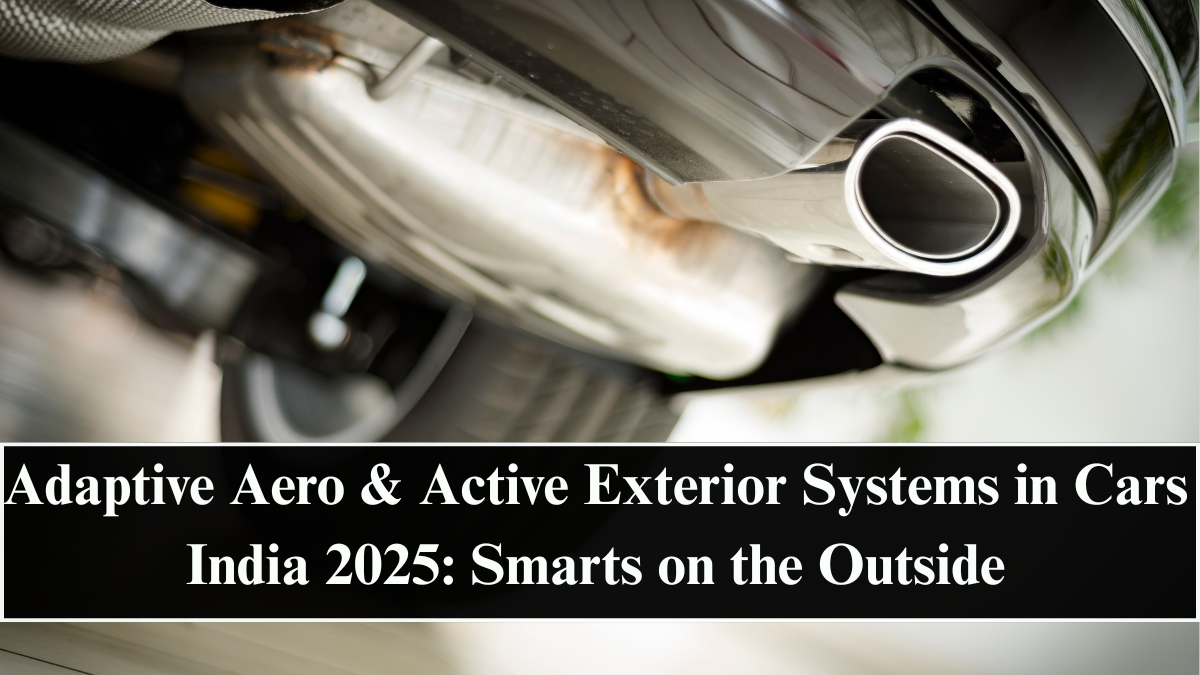Car design in India is entering a new aerodynamic age. With Adaptive Aero & Active Exterior Systems India 2025, vehicles are no longer static machines — they are dynamic structures that adjust in real time to improve performance, efficiency, and safety.
Automakers are combining AI, sensors, and mechatronics to create exteriors that reshape themselves based on driving conditions, speed, and wind resistance. From active spoilers to grille shutters and shape-shifting surfaces, adaptive aerodynamics is redefining how cars behave on the road — and how they save energy in the process.

The Science Behind Adaptive Aerodynamics
Aerodynamics plays a crucial role in how a car cuts through air, directly affecting fuel economy and stability. Traditional vehicles relied on fixed spoilers or air dams, but adaptive aero systems can automatically modify their geometry to respond to the environment.
These include components such as:
-
Active Grille Shutters that open and close to regulate airflow for engine or battery cooling.
-
Adaptive Spoilers and Diffusers that deploy at high speeds to improve downforce and stability.
-
Dynamic Ride Height Control that lowers vehicles at highway speeds to reduce drag.
-
Smart Air Curtains and Flaps that manage turbulence around wheels and underbodies.
In electric vehicles, these systems not only improve aerodynamics but also extend range by reducing drag-related energy loss.
Implementation by Automakers in India
In 2025, automakers in India — including Tata Motors, Hyundai, Mahindra, and MG Motor — are bringing adaptive aerodynamic technologies to both luxury and mass-market models.
For example, Tata’s Avinya EV platform uses active grille shutters and smooth underbody panels for optimized drag reduction. Hyundai’s Ioniq 5 and MG’s Cyberster deploy adaptive spoilers and air curtains that adjust automatically during highway driving.
These innovations, previously exclusive to supercars, are now being localized for India’s road and climate conditions. The focus is on balancing performance, cooling efficiency, and real-world energy savings.
Role of AI and Sensor Integration
Artificial intelligence and sensor fusion are the key enablers of adaptive exterior design. Modern vehicles use LIDAR, radar, and wind pressure sensors to calculate aerodynamic load in real time.
AI algorithms then command actuators to adjust exterior elements for optimal efficiency. For instance, if the system detects crosswinds or cornering at high speed, it can instantly alter spoiler angles or side flap positions for better stability.
In electric vehicles, adaptive aero systems are integrated into the vehicle control unit (VCU), synchronizing with the battery management and cooling systems for maximum efficiency.
Sustainability and Efficiency Gains
Adaptive aerodynamics contribute significantly to India’s broader goal of green and efficient mobility. Improved drag reduction means lower energy consumption, whether it’s fuel in ICE cars or battery power in EVs.
According to 2025 studies by the Automotive Research Association of India (ARAI), active aero systems can enhance energy efficiency by up to 10% on highways. Additionally, optimized airflow management reduces noise and enhances overall driving comfort.
Manufacturers are also using lightweight materials such as carbon composites and shape-memory alloys to make moving aero parts more durable and sustainable.
Beyond Performance: Aesthetic and Functional Design
Adaptive exterior systems are also transforming automotive design philosophy. Cars in 2025 feature sleek, fluid forms with hidden aerodynamic elements that emerge only when needed — combining aesthetics with functionality.
Luxury models are incorporating dynamic lighting, retractable panels, and variable geometry body shells, giving vehicles a futuristic appearance while improving efficiency. Concept EVs from Indian design studios are showcasing exteriors that can literally “breathe” — adjusting ventilation and surface contours dynamically.
The Road Ahead: Intelligent Exteriors for Every Car
By 2025, Adaptive Aero & Active Exterior Systems India are moving from concept prototypes to production-ready technology. As cost and complexity decrease, even mid-segment vehicles will soon feature intelligent aerodynamic systems that respond to real-time conditions.
In the coming decade, with the integration of AI, 5G connectivity, and digital twins, cars will continuously learn and adapt their aerodynamic profiles for maximum efficiency and safety. The exterior will no longer be just a shell — it will be a living, intelligent layer of the car’s overall performance ecosystem.
FAQs
What are adaptive aero systems in cars?
They are systems that adjust a vehicle’s shape or surface elements dynamically to improve aerodynamics, stability, and efficiency.
How do adaptive exteriors improve performance?
By reducing drag, managing airflow, and optimizing cooling, they enhance energy efficiency, handling, and range.
Which automakers in India use adaptive aero features?
Tata Motors, Hyundai, Mahindra, and MG are integrating adaptive spoilers, grille shutters, and active cooling panels in new models.
Are adaptive aerodynamic systems used in EVs?
Yes. In electric vehicles, they are critical for extending range and improving battery cooling through optimized airflow.
What’s the future of adaptive exteriors in India?
With AI and lightweight materials, adaptive aerodynamics will soon become common across segments — merging design, efficiency, and sustainability.
Click here to know more.
